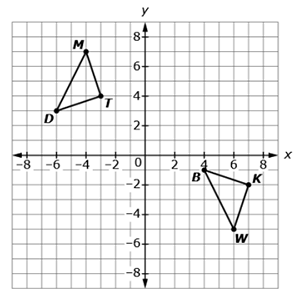Clusters should not be sorted from Major to Supporting and then taught in that order. To do so would strip the coherence of the mathematical ideas and miss the opportunity to enhance the major work of the grade with the supporting clusters.
-
Assessed with:
MAFS.912.G-CO.2.6
- Test Item #: Sample Item 1
- Question:
Triangles BKW and DMT are shown where



This question has three parts.
Rashhaad performs a sequence of transformations on
 to map it to
to map it to  .
.Part A. Which sequence of transformations could be used to map
 to
to  ?
?Part B. The coordinate grid below shows three triangles that could be an intermediate step of Rashaad's sequence of transformations.
Step 1: Use the Add Arrow tool to map the vertices of
 to show the translation (s) chosen in part A.
to show the translation (s) chosen in part A.Step 2: Then, label the transformed triangle by dragging B',K', and W' to the correct vertex.
Part C.
Rashaad wants to justify that

 are sufficient to show that the triangles are congruent.
are sufficient to show that the triangles are congruent.Select words, phrases or equations to complete Rashaad's justification.
- Difficulty: N/A
- Type: : Multiple Types
Related Courses
Related Access Points
Related Resources
Formative Assessments
Lesson Plans
Problem-Solving Tasks
Tutorials
Worksheet
MFAS Formative Assessments
Students are asked to use rigid motion to explain why the ASA pattern of congruence ensures triangle congruence.
Students are asked to use rigid motion to explain why the HL pattern of congruence ensures right triangle congruence.
Students are asked to use rigid motion to explain why the SAS pattern of congruence ensures triangle congruence.
Students are asked to use rigid motion to explain why the SSS pattern of congruence ensures triangle congruence.
Student Resources
Problem-Solving Tasks
This problem solving task ask students to show the reflection of one triangle maps to another triangle.
Type: Problem-Solving Task
In this problem, we considered SSA. The triangle congruence criteria, SSS, SAS, ASA, all require three pieces of information. It is interesting, however, that not all three pieces of information about sides and angles are sufficient to determine a triangle up to congruence.
Type: Problem-Solving Task
This problem solving task challenges students to explain the reason why the given triangles are congruent, and to construct reflections of the points.
Type: Problem-Solving Task
This particular problem solving task exhibits congruency between two triangles, demonstrating translation, reflection and rotation.
Type: Problem-Solving Task
The purpose of this task is primarily assessment-oriented, asking students to demonstrate knowledge of how to determine the congruency of triangles.
Type: Problem-Solving Task
Tutorials
In this tutorial, students will use the SSS, ASA, SAS, and AAS postulates to find congruent triangles
Type: Tutorial
This tutorial discusses the difference between a theorem and axiom. It also shows how to use SSS in a proof.
Type: Tutorial
This tutorial discusses SSS, SAS, ASA and AAS postulates for congruent triangles. It also shows AAA is only good for similarity and SSA is good for neither.
Type: Tutorial
In this video, students will learn about congruent triangles and the "Side-Side-Side" postulate.
Type: Tutorial
Parent Resources
Problem-Solving Tasks
This problem solving task ask students to show the reflection of one triangle maps to another triangle.
Type: Problem-Solving Task
In this problem, we considered SSA. The triangle congruence criteria, SSS, SAS, ASA, all require three pieces of information. It is interesting, however, that not all three pieces of information about sides and angles are sufficient to determine a triangle up to congruence.
Type: Problem-Solving Task
This problem solving task challenges students to explain the reason why the given triangles are congruent, and to construct reflections of the points.
Type: Problem-Solving Task
This particular problem solving task exhibits congruency between two triangles, demonstrating translation, reflection and rotation.
Type: Problem-Solving Task
The purpose of this task is primarily assessment-oriented, asking students to demonstrate knowledge of how to determine the congruency of triangles.
Type: Problem-Solving Task








